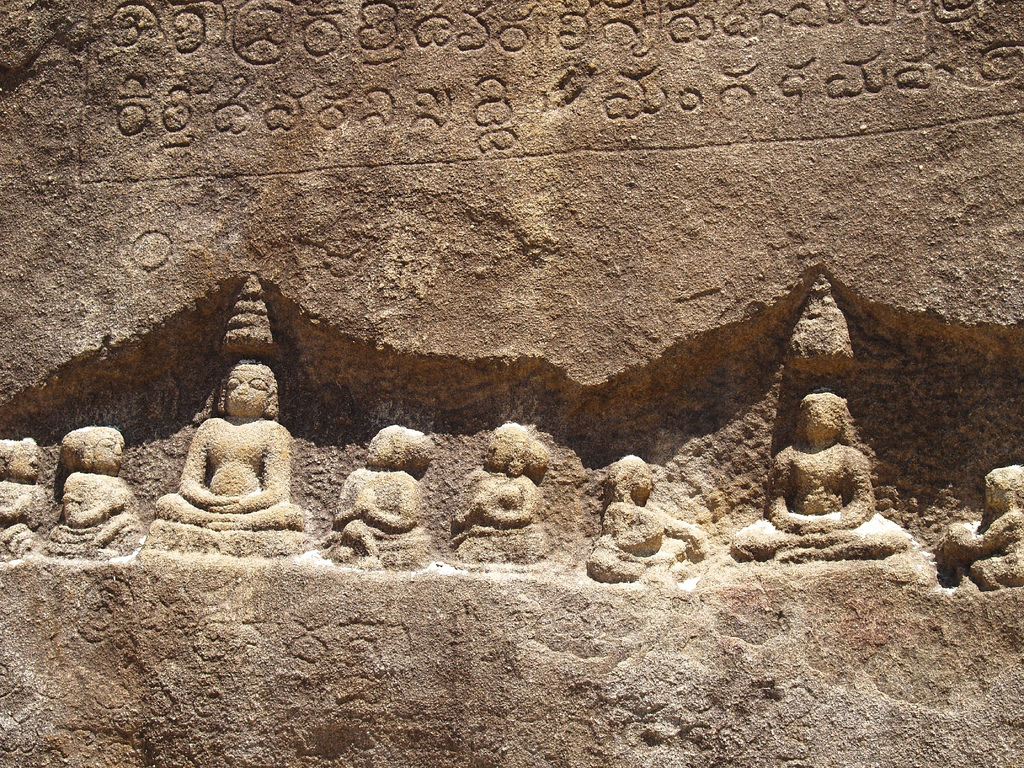
History of Jainism in Karnataka (II)
Monasteries appeared in Karnataka around the century A.D. and later, in places like Gerasoppe, Karkala, Sangitapura, Mudubidire etc. Lineages of teachers are found mentioned in many inscriptions, which show that there was an organized monastic system in the country. This system produced great scholars like Pūjya-pāda, Ravi-kīrti, Samanta-bhadra, Akaḷaṅka, Vādi-rāja, Malliṣeṇa, Vidyānanda etc. Jaina logic, Digambara-puranic literature, ethics, mathematics and many such disciplines had been promoted by Karnataka Jaina scholars through the ages. The Digambara canon, the Ṣaṭkhaṇḍāgama, was written only in Karnataka.
The Yāpanīya sect flourished mostly in Karnataka, and produced great sons like the grammarian, Sākaṭāyana. A fine of Jaina pontiffs had lived in Karnataka during these centuries, who could wield influence on the rulers and channel their help for the benefit of the religion. We find that the pious ladies, officers and kings, when they construct a temple, install an image or provide for the maintenance of the deity and the monks. In many cases, the lineage of the preceptors etc., are given. From these references, we understand that the Jaina pontiffs were highly respected and influential.
 |
Entrance of Neminatha basadi and inscription of 13th century CE, Varanga (Udupi district). |
Jaina monasticism obtained new dimensions in Karnataka after the 10th century A.D. Some of the Jaina temples became immensely rich owing to the grants and donations these institutions got from generous lay-men, potentates, officers etc. The Jaina monks were supposed to wander about unless it was the rainy season, when they were supposed to devote their time for learning and teaching, as well as for austerities. They were supposed to get their food by going on begging tours. But many of the grants were made for the maintenance of the monks and nuns attached to a temple. This change tethered them to the basadis, where the original zeal got diminished.
The maṭhas became very influential and Digambara Jainism in this state is known for its Bhattaraka (bhaṭṭāraka) system. There are five seats of Bhattarakas in Karnataka: in Shravana-belgola, Hombuja, Varanga, Mudubidire and Shimoga. These institutions could accumulate immense wealth for the maintenance and conservation of which, they had to form a machinery.
 |
Rock-cut images of seated and standing Tirthankaras, Shravanabelgola. |
Another turn, Karnataka Jainism took was towards the development of Tantrism. Asceticism, including meditation etc., was pushed back and rituals and forms of worship, rose to prominence.
Karnataka Jainism produced very good administrators and generals. Chamunda-raya, Hulla, Nāga-dēva, Gaṅga-rāja etc., are examples. Not only the Jainas, but the whole Kannadigas benefitted from their administrative services.
In the fields of art, architecture, literature etc., the contributions of Karnataka Jainism are considerable. The Jainas enriched Kannada literature to a great extent and the literary works were meant as a means for the propagation of the dharma. The temples or basadis of Karnataka extend from perhaps the 7th century A.D., and consist of different types, from cave temples to temples made in marble. Gommateśvara icons are a peculiarity of Karnataka. The Tirthankara images all look alike, but the sculptors have made them very beautiful and attractive by adding the various parikaras and other such devices.
 |
Rock-cut images of seated Tirthankaras, Sharavanabelgola. |
From the last two decades of the eighteenth century, the influence of Jainism waned in Karnataka. With the subsidence of the influence, the creative power of the Jainas marked a low ebb. Their magnificent monuments in some places in Karnataka were in ruins. However, even today, organized Jaina activities are found in places like Shravana-belgola, Hombuja, Venuru, Mudubidire, Karkala, Dharma-sthaḷa etc.
Bibliography:- History of Jainism in Karnataka in Dravidian Encyclopaedia, Vol. I, ed. V.I. Subramoniam, ISDL, Thiruvananthapuram, 1990;
- P.B. Desai, Jainism in South India and Some Jaina Epigraphs, Jainasamskriti Samrakshakasamgha, Sholapur 1957.
- R.C. Majumdar / A.S. Altekar, Vākāṭaka Gupta Age, Motilal Banarsidass, New Delhi 1967.
- Krishna Murari, Cāḷukyas of Kalyāṇi, Concept Publishing Co., Delhi.
- K.A. Nilakanta Sastri, History of South India (4th ed.), Oxford University Press, Madras 1968.
- K.V. Ramesh, A History of South Canara, Karnataka University, Dharwar 1970.
- A.S. Altekar, The Rashtrakutas and their Times, Poona 1934.
- T.G. Kalghatgi, Jainism and Karnataka Culture, Karnataka University, Dharwar 1977.
- H.V. Sreenivasa Murthy / R. Ramakrishnan, History of Karnataka, Chand &Co., Delhi 1978.
- Rambhushan Prasad Singh, Jainism in Early Medieval Karnataka, Motilal Banarsidass, Delhi 1975.
- E. Rapson (ed.), The Cambridge History India Vol. I, Chand &Co, Delhi 1962.
- B.A. Salatore, Ancient Karnataka (Vol. II), Oriental Book Agency, Poona 1936.
 P.M. Joseph
P.M. Joseph